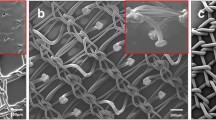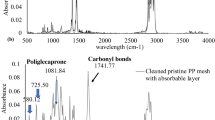Abstract
Contraction is a well-documented phenomenon occurring within two months of mesh implantation. Its etiology is unknown, but it is suggested to occur as a result of inadequate tissue ingrowth into the mesh and has been associated with hernia recurrence. In continuation of our previous studies, we compared tissue ingrowth characteristics of large patches of polyester (PE) and heavyweight polypropylene (PP) and their effect on mesh contraction. The materials used were eight PE and eight PP meshes measuring 10 × 10 cm2. After random assignment to the implantation sites, the meshes were fixed to the abdominal wall fascia of swine using interrupted polypropylene sutures. A necropsy was performed three months after surgery for evaluation of mesh contraction/shrinkage. Using a tensiometer, tissue ingrowth was assessed by measuring the force necessary to detach the mesh from the fascia. Histologic analysis included inflammatory and fibroblastic reactions, scored on a 0–4 point scale. One swine developed a severe wound infection that involved two PP meshes and was therefore excluded from the study. The mean area covered by the PE meshes (87 ± 7 cm2) was significantly larger than the area covered by the PP meshes (67 ± 14 cm2) (p = 0.006). Tissue ingrowth force of the PE meshes (194 ± 37 N) had a trend toward being higher than that of the PP meshes (159 ± 43 N), although it did not reach statistical significance. There was no difference in histologic inflammatory and fibroblastic reactions between mesh types. There was a significant correlation between tissue ingrowth force and mesh size (p = 0.03, 95% CI: 0.05–0.84). Our results confirm those from previous studies in that mesh materials undergo significant contraction after suture fixation to the fascia. PE resulted in less contraction than polypropylene. A strong integration of the mesh into the tissue helps prevent this phenomenon, which is evidenced by a significant correlation between tissue ingrowth force and mesh size.






Similar content being viewed by others
References
The EU Hernia Trialists Collaboration. Repair of groin hernia with synthetic mesh. Meta-analysis of randomized controlled trials. Ann. Surg. 2002;235:322–332
Vrijland WW, van den Tol MP, Luijendijk RW, et al. Randomized clinical trial of non-mesh versus mesh repair of primary inguinal hernia. Br. J. Surg. 2002;89:293–297
MRC Laparoscopic Groin Hernia Trial Group. Laparoscopic versus open repair of groin hernia: a randomized comparison. Lancet 1999;354:185–190
Silich RC, McSherry CK. Spermatic granuloma: an uncommon complication of the tension-free repair. Surg. Endosc. 1996;10:537–539
Gray MR, Curtis JM, Elkington JS. Colovesical fistula after laparoscopic inguinal hernia repair. Br. J. Surg. 1994:81:1213–1214
Amid P. Classification of biomaterials, their related complications in abdominal wall hernia surgery. Hernia 1997;1:5–8
Schumpelick V, Arit G, Schlachetzki A, et al. Chronic inguinal pain after transperitoneal mesh implantation. Case report of net shrinkage. Chirurg 1998;69:489–491
Klinge U, Klosterhalfen B, Muller M, et al. Shrinking of polypropylene mesh in vivo: an experimental study in dogs. Eur. J. Surg. 1998;164:965–969
Gonzalez R, Ramshaw BJ. Comparison of tissue integration between polyester and polypropylene prostheses in the preperitoneal space. Am. Surg. 2003;69:471–477
Klinge U, Conze J, Klosterhalfen B, et al. Changes in abdominal wall mechanics after mesh implantation. Experimental changes in mesh stability. Langenbecks Arch. Chic. 1996;381:323–332
Schumpelick V, Klinge U, Welty G, et al. Meshes within the abdominal wall. Chirurg 1999;70:876–887
Steed DL. Wound-healing trajectories. Surg. Clin. North. Am. 2003;83:547–555
Di Vita G, Milano S, Frazzetta M, et al. Tension-free hernia repair is associated with an increase in inflammatory response markers against the mesh. Am J Surg 2000;180:203–207
Beets GL, Go PM, van Mameren H. Foreign body reactions to monofilament and braided polypropylene mesh used as preperitoneal implants in pigs. Eur J Surg 1996;162:823–825
Klinge U, Blosterhalfen B, Müller M, et al. Foreign body reaction to meshes used for the repair of abdominal wall hernias. Eur. J. Surg. 1999;165:665–673
Schachtrupp A, Klinge U, Junge K, et al. Individual inflammatory response to human blood monocytes to mesh biomaterials. Br. J. Surg. 2003;90:114–120
Bellón JM, Buján J, Contreras L, et al. Integration of biomaterials into abdominal wall: process of scar formation and macrophage response. Biomaterials 1995;16:381–387
Klinge U, Klosterhalfen B, Birkenhauer V, et al. Impact of polymer pore size on the interface scar formation in a rat model. J. Surg. Res. 2002;103:208–214
Junge K, Linge U, Rosch, et al. Functional and morphologic properties of a modified mesh for inguinal hernia repair. World J. Surg. 2002;26:1472–1480
Bellón JM, Buján J, Contreras LA, et al. Comparison of a new type of polytetrafluoroethylene patch (Mycro Mesh) and polypropylene prosthesis (Marlex) for repair of abdominal wall defects. J. Am. Coll. Surg. 1996;183:11–18
Lingen MW. Role of leukocytes and endothelial cells in the development of angiogenesis in inflammation and wound healing. Arch. Pathol. Lab. Med. 2001;125:67–71
Bellón JM, Contreras LA, Sabater C, et al. Pathologic and clinical aspects of repair of large incisional hernias after implant of a polytetrafluoroethylene prosthesis. World J. Surg. 1997;21:402–406
Nien YD, Man YP, Tawil B, et al. Fibrinogen inhibits fibroblast-mediated contraction of collagen. Wound Repair Regen. 2003;11:380–385
Marois Y, Cadi R, Gourdon J, et al. Biostability, inflammatory response, and healing characteristics of a fluoropassivated polyester-knit mesh in the repair of experimental abdominal hernias. Artif. Organs 2000;24:533–543
Klosterhalfen B, Klinge U, Schumpelick V. Functional and morphological evaluation of different polypropylene mesh modifications for abdominal wall repair. Biomaterials 1998;19:2235–2246
Ferrando JM, Vidal J, Armengol M, et al. Early imaging of integration response to polypropylene mesh in abdominal wall by environmental scanning electron microscopy comparison of two placement techniques and correlation with tensiometric studies. World J. Surg. 2001;25:840–847
Author information
Authors and Affiliations
Corresponding author
Rights and permissions
About this article
Cite this article
Gonzalez, R., Fugate, K., McClusky, D. et al. Relationship Between Tissue Ingrowth and Mesh Contraction. World J. Surg. 29, 1038–1043 (2005). https://doi.org/10.1007/s00268-005-7786-0
Published:
Issue Date:
DOI: https://doi.org/10.1007/s00268-005-7786-0




